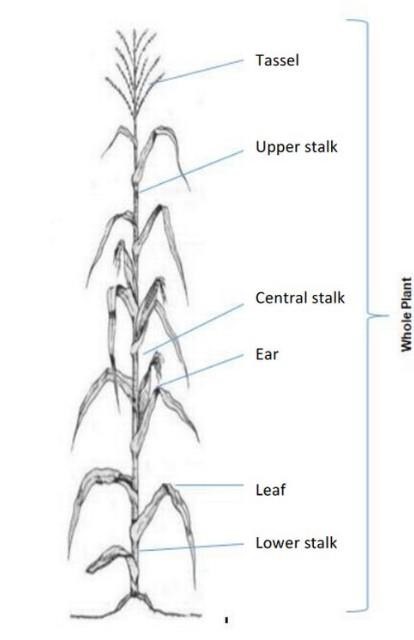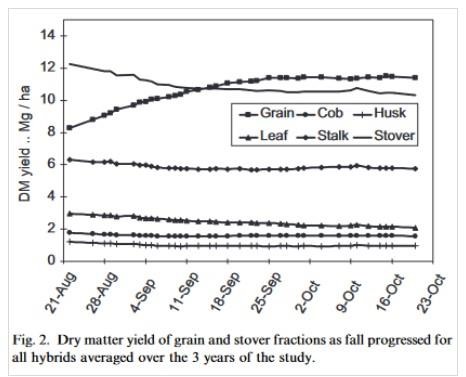By Jerad Jaborek
Nowadays, there are many different methods used to harvest the corn plant. The use of different types of combine heads, forage processors, rollers, and knives to harvest the corn plant can affect the composition of the final feedstuff produced. These different harvesting methods can often lead to confusion when discussing the feedstuff being produced from the corn plant or being purchased for cattle feed. This article provides some clarity about the different feedstuffs produced from the corn plant, their compositional differences, how those compositional differences affect the nutrient composition of the feedstuff, and the use of these feedstuffs in finishing diet.

Picture 1. The corn plant and its different fractions.
By including different parts of the corn plant (e.g., grain, cob, husk, leaves, stalk; Picture 1) the physical composition and nutritional composition of the feedstuff change. Table 1 presents the relative contribution, nutritive value, and in vitro dry matter digestibility of each fraction to the whole corn plant on a dry matter basis. As the corn plant matures, the non-grain stover fraction (e.g., cob, husk, leaf, stalk) become less digestible and dry matter losses can increase due to leaf and stalk breakage (Picture 2).

Picture 2: Dry Matter yield of the corn grain and stover fractions during the growing season averaged across three years. Diagram credit: Shinners and Binversie, 2007.
However, whole corn plant digestibility increases due to the increasing contribution of the grain as the plant matures. Digestibility can also be affected by other factors such as corn plant variety, theoretical length of cut, and maturity of the corn plant at harvest. Next, we will discuss the differences between the various feedstuffs that can be produced from the whole corn plant resulting in different proportions of grain and stover.
Table 1. Composition and digestibility of the various corn plant fractions at maturity |
Fraction | Proportion of plant (%, DMB) | CP (%) | NDF (%) | IVDMD (%) |
Grain | 45.9 | 7.8-9.8 | 7-11 | 95-96 |
Cob | 8.2 | 3.3-7.9 | 74-78 | 44-52 |
Husk | 7.0 | 3.6-5.4 | 76-78 | 54-64 |
Leaves | 11.4 | 8.6-10.4 | 64-65 | 64-65 |
Stalk | 27.5 | 4.6-4.9 | 68-72 | 47-54 |
Data from Pordesimo et al., 2005; NASEM, 2016; Horst et al., 2020; Horst et al., 2021. |
Corn silage is created by harvesting the whole corn plant with a chopper, either pull-behind or self-propelled, and then ensiled. Chop height can impact overall corn silage quality, as this adjusts the amount of the less digestible lower stalk portion that is included in the feed. The next few methods for harvesting the corn plant that will be discussed often create some confusion concerning the proper name for the resulting feedstuff; snaplage versus earlage. Snaplage is harvested with a forage harvester that includes a corn snapper head before being ensiled. Snaplage includes the grain, cob, husk, and some of the upper portion of the stalk which may include some leaves. Earlage, as its name implies, only includes the grain, cob, and possibly some husk. Earlage is harvested with a forage chopper with an all-crop head, before being ensiled. Think of earlage as the high moisture version of dry ear corn. Dry ear corn is produced when the grain, along with a portion of the cob, is harvested with a combine or corn picker. As just mentioned, the ear can be harvested with a combine to return only the grain portion for either dry whole shelled corn or high moisture corn depending on plant maturity and moisture level at harvest. Subsequently, the remaining fraction of the corn plant after harvesting dry rolled corn or high moisture corn is the stover portion of the corn plant. The stover portion can be used as an inexpensive source of fiber in cattle diets and/or is commonly used as a bedding source for cattle.
Table 2. Nutrient Composition of the different feedstuffs produced from the whole corn plant by using different harvest methods |
Feedstuff | DM (%) | TDN (%) | NEm (Mcal/lb) | NEg (Mcal/lb) | CP (%) | NDF (%) |
Dry Rolled Corn | 87.2 | 87.6 | 0.99 | 0.68 | 8.8 | 9.7 |
High Moisture Corn | 70.5 | 90.4 | 1.02 | 0.71 | 8.8 | 9.9 |
Ear Corn | 83.3 | 84.6 | 0.94 | 0.64 | 8.3 | 19.4 |
Earlage | 62.5 | 84.3 | 0.94 | 0.64 | 8.1 | 21.0 |
Snaplage | 58.9 | 82.0 | 0.91 | 0.61 | 8.1 | 23.3 |
Corn Silage | 33.1 | 67.7 | 0.71 | 0.44 | 8.2 | 43.0 |
Corn Stalks | 85.8 | 52.7 | 0.48 | 0.23 | 6.1 | 70.8 |
NASEM, 2016. Nutrient Requirements of Beef Cattle (Eighth Revised Edition). |
The resulting tonnage of each feedstuff, on a dry matter basis, also varies because of the inclusion or exclusion of the various corn plant fractions in each feedstuff. Johnson and others from the University of Minnesota reported differences in dry matter yield for the different feedstuffs harvested from the corn crop; corn silage with 32.7 tons per acre, earlage with 25.0 tons per acre, high moisture corn with 19.9 tons per acre, and dry rolled corn with 16.9 tons per acre. These feedstuffs resulting from these different corn plant harvesting techniques have different nutritional compositions (Table 2). Therefore, each of the different feedstuffs in Table 2 offer different concentrations of nutrients that are needed to meet the nutritional requirements of your cattle. Alone they may exceed or may not exceed or meet the requirements of your cattle, so proper ration balancing is needed to provide your cattle with a diet that meets their nutrient requirements.
Table 3. Composition of example diets (on a dry matter basis) and the resulting nutrient composition |
Feedstuff | Diet #1 | Diet #2 | Diet #4 | Diet #5 | Diet #6 | Diet #7 | Diet #8 |
High Moisture Corn, % | 50 | 55 | 20 | 30 | 40 | - | 10 |
Earlage, % | - | - | - | - | - | 70 | 60 |
Snaplage, % | - | - | 50 | 40 | 30 | - | - |
Corn Silage, % | 20 | 15 | - | - | - | - | - |
Dry Distillers Grain, % | 25 | 25 | 25 | 25 | 25 | 25 | 25 |
Mineral Supplement, % | 5 | 5 | 5 | 5 | 5 | 5 | 5 |
Diet Composition | ----------Dry Matter Basis ---------- |
NEg, Mcal/lb | 0.61 | 0.63 | 0.62 | 0.63 | 0.64 | 0.62 | 0.63 |
CP, % | 12.8 | 12.9 | 12.8 | 12.9 | 12.9 | 12.7 | 12.7 |
NDF, % | 21.8 | 20.2 | 22.1 | 20.8 | 19.5 | 23.2 | 22.1 |
Some example finishing diets using high moisture corn, earlage, snaplage, and corn silage are shown in Table 3 with 25% dry distiller’s grains and 5% mineral supplement. With the distiller’s grain being used as a protein source, we can modify the energy and fiber in the diet with the amount of corn grain and amount of stover portion supplied. The goal of our feedlot diet is to maximize energy utilization for gain while providing enough roughage to buffer the rumen pH to prevent digestive upsets that cause acidosis, bloat, or liver abscesses. Consult with your nutritionist or Michigan State University Extension beef educator for help with balancing your diets. The different feedstuffs that can be made from the corn crop offer a lot of flexibility in designing a diet that works for your operation. Additionally, the price of corn may influence your diet balancing decisions if trying to create a least cost ration, as discussed in another article about corn silage inclusion levels in feedlot diets. If you are looking for information on how to price earlage, snaplage, or corn silage, MSU Extension has some resources that can provide you with some guidance on how to determine a price based on the value of the grain and roughage fractions.
Source : msu.edu